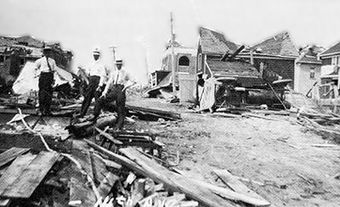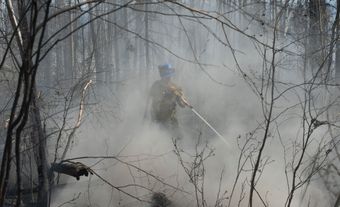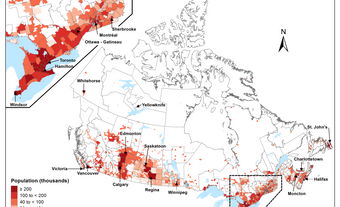The Regina Cyclone was an F4-scale tornado that struck Regina, Saskatchewan on 30 June 1912. It is generally considered the deadliest tornado in Canadian history. It killed 28 people, injured 300, and left about 2,500 temporarily homeless. The tornado also destroyed half the city’s businesses and 200 of its homes, causing at least $1.2 million in damage (roughly $30.5 million in today’s dollars). Rebuilding took two years, while paying off the rebuilding debt took a decade.

Cyclone or Tornado?
Though it was called a cyclone at the time, the abnormal weather event that struck Regina on 30 June 1912 is more accurately described as a tornado. A cyclone is a general term used to refer to air rotating around and moving toward a low-pressure centre (in the Northern Hemisphere, this rotation is almost always counterclockwise). A tornado is a small-scale cyclonic circulation. Therefore, while it is not inaccurate to call the event the “Regina Cyclone,” given its size, it is more specific to call it a tornado.Did you know?
While meteorologists rate the Regina Cyclone as a level four storm on the Fujita Scale, both Canada and the United States now use the Enhanced Fujita Scale when assessing storm severity. Adopted by Canada in 2013, the EF-Scale is an improved version of the Fujita Scale, which Japanese-American meteorologist Tetsuya Theodore Fujita developed in the 1960s. Both scales use a six-level rating system; however, the enhanced version offers more accurate wind-speed estimations, among other improvements. The enhanced scale has only been used to rate tornados that have occurred since its implementation; any storm that occurred prior to April 2013 — including historic events like the Regina Cyclone — have so far retained their F-Scale rating.
Size of the Tornado
It is difficult to precisely measure the exact strength of the Regina Cyclone for several reasons. For one, in 1912, there was no universally accepted method of measuring tornadoes. Technological limitations of the day, coupled with the fact that the tornado caught the people of Regina by surprise, made it impossible to accurately measure the wind speed. Therefore, estimates of the tornado’s size and scale are guesses based on eyewitness reports, the damage caused and other characteristics that have since been compared to tornadoes for which more accurate scientific data is available. Based on the information available to them, meteorologists suggest that the Regina Cyclone was a level four storm on the Fujita Scale, meaning it had wind speeds of between 330 and 410 km/h.
Overview
The 1 July 1912 edition of The Morning Leader (predecessor of today’s Regina Leader-Post), reported that on Sunday 30 June 1912:
the peaceful calm of the Sabbath afternoon had led hundreds to seek comfort at the lake. Hundreds of others wandered aimlessly about the streets and to and fro in the parks. Others lounged in the comparatively cool shade of their homes, or sweltered in the heat of the sun as it chanced, and all eyed with favour the growing clouds that gathered from the south, bearing a cooling breeze or two in their fore.
Regina residents, then a community of 30,000, had festooned the city with 1,000 flags in preparation for Dominion Day (now called Canada Day).
At about 4:50 pm local time, the clouds that had been gathering slowly and silently south of the city transformed into a fast moving storm. The storm brought rain, hail and tremendous winds. The tornado formed about 18 km south of Regina and made its way through several farms before travelling north through the city. As reported in The Morning Leader, “Never in the history of a healthy, optimistic, growing Western city has happened a catastrophe so appalling, so paralyzing, in its awfulness.” While the tornado was only on the ground for about six minutes, and was likely only about 150 m wide, it carved a path of destruction ranging from 300 to 400 m in width and about nine city blocks in length. Those standing just outside the affected region were able to watch the destruction in relative safety. The Morning Leader described Reginans’ shocked and bewildered reaction to the tornado, writing that people laughed and “looked with amusement upon the queer pranks of the storm fiend” such as a barrel rolling down the street that narrowly missed hitting a man running for cover.
The Morning Leader continued publishing despite the storm, listing the names of the dead and the injured, giving instructions to the public from the authorities, and detailing the city’s cleaning, recovery and rebuilding efforts.

Scope of the Destruction
The Regina Cyclone killed 28 people and left about 300 injured. In addition, about 2,500 people were left homeless and about 500 of the city’s buildings, many of which had only recently been completed, were destroyed. That the tornado was accompanied by torrential rain and hail likely saved many buildings from being ruined by the fires that started in the wake of the storm. Among the prominent buildings damaged or destroyed by the tornado were the government telephone exchange, the Canadian Pacific Railway Freight Depot, the Metropolitan Methodist Church, the Knox Presbyterian Church, the YMCA and YWCA, as well as the city’s brand new central library, which had opened just six weeks before the storm. Estimates of the property damage caused by the tornado range from $1.2 million to $5 million (approximately $30.5 million to $128 million in 2022 dollars).

 Share on Facebook
Share on Facebook Share on X
Share on X Share by Email
Share by Email Share on Google Classroom
Share on Google Classroom



